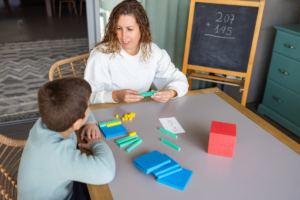
School-Family-Community Partnership: Supporting Students with Special Needs
School-Family-Community Partnership: Strengthening Support for Students with Special Needs
The education of students with special needs is a complex and challenging task that requires the collaboration of multiple stakeholders. The traditional model of education, where the teacher is the sole provider of knowledge and the student is the passive recipient, is no longer adequate to meet the diverse needs of students with special needs. In recent years, there has been a growing recognition of the importance of school-family-community partnerships in promoting the academic and social success of students with special needs.
A school-family-community partnership is a collaborative effort between schools, families, and community organizations to support the academic, social, and emotional development of students. This partnership involves the sharing of information, resources, and expertise to create a supportive and inclusive learning environment for all students. The goal of this partnership is to strengthen the support network for students with special needs and to ensure that they receive the necessary services and accommodations to achieve their full potential.
Conceptual Framework of School-Family-Community Partnerships
Defining Partnerships
School-Family-Community Partnerships (SFCP) refer to collaborative efforts between schools, families, and communities to support student learning and development. This partnership involves sharing responsibility for student success, promoting effective communication, and building trust and respect among all stakeholders.
SFCP is based on the belief that when families and communities are involved in their children’s education, positive outcomes are more likely to occur. This partnership is essential for students with special needs, as it provides a supportive environment that promotes their academic, social, and emotional growth.
Benefits for Students with Special Needs
SFCP has numerous benefits for students with special needs. When families and communities are involved in their education, students with special needs are more likely to receive the support they need to succeed. This support can come in various forms, such as additional resources, specialized services, and accommodations.
Moreover, SFCP provides students with special needs with a sense of belonging and acceptance. This sense of belonging helps to improve their self-esteem and confidence, which can lead to improved academic and social outcomes.
In conclusion, SFCP is a critical component of supporting students with special needs. It provides a collaborative and supportive environment that promotes their academic, social, and emotional growth. By working together, schools, families, and communities can create a positive and inclusive learning environment for all students.
Legislative and Policy Foundations
School-family-community partnerships for students with special needs are built on a foundation of legislative and policy frameworks that aim to ensure access to quality education for all students. Two key pieces of legislation that have shaped special education in the United States are the Individuals with Disabilities Education Act (IDEA) and the Every Student Succeeds Act (ESSA).
Individuals with Disabilities Education Act (IDEA)
IDEA is a federal law that ensures that children with disabilities receive a free, appropriate public education (FAPE) in the least restrictive environment (LRE) possible. It requires that schools provide individualized education programs (IEPs) for each student with a disability, outlining the student’s unique needs and the services and supports necessary to meet those needs. IDEA also mandates that parents be involved in the decision-making process and provides procedural safeguards to protect the rights of students with disabilities and their families.
Every Student Succeeds Act (ESSA)
ESSA is the most recent reauthorization of the Elementary and Secondary Education Act (ESEA) and was signed into law in 2015. It aims to ensure that all students have access to a high-quality education and provides more flexibility to states and local school districts in designing and implementing education programs. ESSA includes provisions for supporting students with disabilities, including requirements for states to set goals and measure progress for students with disabilities and to provide professional development for educators who work with these students.
Overall, the legislative and policy frameworks provided by IDEA and ESSA lay the foundation for school-family-community partnerships that support students with special needs. By working together, schools, families, and communities can ensure that these students receive the education and services they need to succeed.
Implementation Strategies for Effective Partnerships
Collaboration between schools, families, and communities is essential for supporting students with special needs. However, building and maintaining effective partnerships can be challenging. Here are some implementation strategies that can help create successful partnerships.
Collaborative Team Approaches
One effective approach to building partnerships is to create collaborative teams that include school staff, families, and community members. These teams can work together to develop plans and strategies for supporting students with special needs. Collaborative teams can also help to ensure that all stakeholders have a voice in the decision-making process.
Communication and Relationship Building
Effective communication is essential for building strong partnerships. Schools should establish regular communication with families and community members to keep them informed about student progress and any changes in the student’s educational plan. Communication should be two-way, with opportunities for families and community members to provide feedback and ask questions.
Relationship building is also critical for creating successful partnerships. Schools should strive to build positive relationships with families and community members based on mutual trust and respect. This can be achieved through regular communication, active listening, and a willingness to work together to support students with special needs.
Cultural Competence
Cultural competence is essential for building partnerships with families and community members from diverse backgrounds. Schools should strive to understand the cultural values and beliefs of families and community members and work to incorporate them into educational planning. This can help to create a more inclusive and welcoming environment for all students.
In conclusion, effective partnerships between schools, families, and communities are essential for supporting students with special needs. By using collaborative team approaches, effective communication, and cultural competence, schools can build strong partnerships that benefit all stakeholders.
Evaluating Partnership Outcomes
Partnerships between schools, families, and communities can be instrumental in supporting students with special needs. However, it is important to evaluate the outcomes of such partnerships to ensure that they are effective and meeting the needs of all stakeholders.
Assessment and Data-Driven Decision Making
Assessment is an important part of evaluating partnership outcomes. Schools, families, and communities can use various assessment tools to determine the effectiveness of their partnership. For example, they can use surveys to gather feedback from stakeholders about their experiences with the partnership. They can also use data to track student progress and identify areas where the partnership can be improved.
Data-driven decision making is another important aspect of evaluating partnership outcomes. Schools, families, and communities can use data to identify areas where the partnership is working well and areas where it needs improvement. They can then use this information to make informed decisions about how to improve the partnership and better support students with special needs.
Feedback Mechanisms and Continuous Improvement
Feedback mechanisms are essential for evaluating partnership outcomes. Schools, families, and communities should establish regular feedback mechanisms to gather input from stakeholders about their experiences with the partnership. This feedback can then be used to make improvements to the partnership and better support students with special needs.
Continuous improvement is also important for evaluating partnership outcomes. Schools, families, and communities should be committed to continuously improving the partnership to ensure that it is effective and meeting the needs of all stakeholders. This can involve regular assessments, data-driven decision making, and feedback mechanisms to identify areas where the partnership can be improved and make necessary changes.
Overall, evaluating partnership outcomes is crucial for ensuring that schools, families, and communities are effectively supporting students with special needs. By using assessment tools, data-driven decision making, feedback mechanisms, and continuous improvement, stakeholders can work together to create a partnership that meets the needs of all involved.
Challenges and Solutions in Partnership Development
Barrier Identification
Developing partnerships between schools, families, and communities can be a challenging process, especially when it comes to supporting students with special needs. One of the first steps in successful partnership development is identifying the barriers that may exist. Some common barriers include lack of communication, differing expectations, and limited resources.
To overcome these barriers, it is important to establish clear lines of communication between all parties involved. This can be achieved through regular meetings, open dialogue, and the use of technology to facilitate communication. Additionally, it is important to establish a shared vision and goals for the partnership, and to ensure that all parties have a clear understanding of their roles and responsibilities.
Strategic Planning and Resource Allocation
Another key challenge in partnership development is strategic planning and resource allocation. In order to effectively support students with special needs, it is important to have a clear plan in place that outlines the specific goals and objectives of the partnership. This plan should also include a detailed budget and resource allocation strategy.
To ensure that resources are allocated effectively, it is important to involve all stakeholders in the planning process. This can include parents, teachers, administrators, community leaders, and other relevant parties. By involving all stakeholders, it is possible to develop a comprehensive plan that addresses the unique needs of each student and ensures that resources are allocated in a way that maximizes their impact.
Overall, developing partnerships between schools, families, and communities can be a challenging process, but it is essential for supporting students with special needs. By identifying barriers and developing a clear plan for resource allocation, it is possible to create effective partnerships that benefit all parties involved.














Publicar comentário